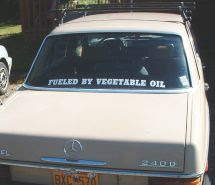Wow, here's where you open the can'o'worms.
In the good ol' US of A you have 4 major SVO (WVO, VegOil) kits to choose from. All of these kits have been used successfully in Alaska, as well as kits by smaller manufacturers and homemade custom kits.
Which is best? IMHO there is NO PERFECT WAY to convert your vehicle. There are, however, several different good ways to convert.
My personal order of preference is:
1. PlantDrive (aka Neoteric Biofuels)
2. Frybrid3. Golden Fuel Systems (aka Greasel)4. GreaseCarWhy PlantDrive? Well, honestly, when I converted my first vehicle Frybrid didn't exist so I went with PlantDrive (then known as Neoteric Biofuels). I'm happy with the results and am comfortable with the system.
PlantDrive kits consist of a box of major components sourced from Big-Rig cold-weather parts. They retrofit Semi-truck/Tractor trailer cold-weather equipment to SVO use on passenger vehicles. This stuff is not going to break, it's top of the line.
It is a great a la carte approach where you can pick and choose the parts you need. On the other hand it is expensive and the "kit" you get doesn't include everything (it lacks fuel lines/tank/little connectors), but you do get the *nice* VegTherm heater invented by Ed Beggs.
Why Frybrid? Chris Goodwin at Frybrid is very well respected for his research and development. He's taken the opposite approach as PlantDrive and has created a high-quality line of SVO-specific parts mostly made from scratch.
His kits include everything, tank, pickup, lines, filter, valves, and computer control. Frybrid also has amazing installation manual and a great VegOil
forum. His use of aluminum lines and hydraforce valves have become the defacto standard for many folks.
These are great if you need it all, and are willing to solidly mount your stuff (I prefer flexible HOH lines with my Plantdrive kit so I can remove my tank for filling or move the lines around to work on the engine, but those HIH lines look *much* prettier and most likely heat more effectively.)
Why Golden Fuel Systems? Well, Charlie Anderson has roots in Alaska, and he has created some nice tanks and lines, and uses some solid filters. They have evoled significantly throughout the years, and the new stuff looks pretty good. His systems have run on new vehicles in cold northern Alaska winters.
I, however, have a philosophical disagreement with their system. Golden Fuel says that the engine is the heat exchanger and the purpose of the SVO system is to get the oil to flow to the engine. Frybrid and others maintain that the oil MUST BE HOT before injection to prevent damage to the engine. I subscribe to the latter view. I know of a Golden Fuel System conversion in Alaska where the owner has added a PlantDrive VegTherm and HotPlate to boost the temperatures and additional 20-30 degrees F. I am fine with a Golden Fuel kit as the base. but would add extra heat before the heat exchanger.
Why Greasecar? Well, to
quote Justin Soares from
GreaseWorks:
"Grease Car may have been the first on the scene, but they've also been the slowest to keep up with the learning curve."
Personally I am not as familiar with the Greasecar system, it only has 3 heat exchangers (tank, lines, filter) like the Golden system, as opposed to the 4 used by Frybrid (tank, lines, filter, heat exchanger) or the 5 on my (non-stock) PlantDrive system (tank, lines, filter, heat exchanger, VegTherm 12v heater). They use copper in the fuel tank, and have in-tank fittings that make me nervous about fuel/coolant contamination. I know of 2 GreaseCar conversions in Alaska, both of which have had mediocre reviews by the owners.
Like I said, there's no perfect way. If you have an old beater to drive into the ground, spend as little as possible, and don't worry about engine damage. If you've got a spare tank lying around, pick and choose from a PlantDrive system. Like clean installs and need everything, try Frybrid.
Veg On!
 13 million gallons of Alaska's fish oil is lost every year.
13 million gallons of Alaska's fish oil is lost every year.
 A hundred miles upriver from Fairbanks, springing from the abandoned fields of the Delta Barley Project, is the site for the
A hundred miles upriver from Fairbanks, springing from the abandoned fields of the Delta Barley Project, is the site for the 
